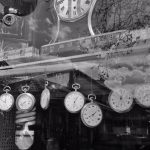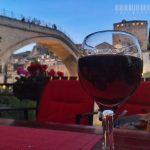I’m editing travel photography while drinking my last Bosnian coffee. What’s Bosnian coffee, you might ask? Turkish coffee served in Bosnia. Yeah, that simple.
Ottomans ruled Bosnia for 425 years, ending in 1878, and accounting for Muslim and Turkish influences found throughout the nation.
Sitting under shade at 1pm, it’s a sweltering 29C. Fahrenheit? Pfft. It roughly converts to “too hot for my fishbelly-white ass,” but I still enjoy it. I hide out at this time of day, though, lest I be like bacon and get crispy.
Maddening throngs of tourists gather 50 feet from me, on expensive day trips. All in the same spot, hoping for magnificent travel photography of the infamous Mostar Stari Most/Old Bridge.
But just 500 metres down the river is another bridge that clearly offers the best option for travel photography. Are there any tourists on that bridge getting photos? Maybe five. I was, last night.

This is angle, cropping, and editing at work. I had to get the camera down at table level, had to focus on the glass, and kept moving the glass an inch or two to get the right shot.
The Photographer’s Lament
Upon sharing said shot-from-a-bridge-too-far Stari Most photos on Facebook and Twitter last night, for the millionth time, someone asked what I took my photos with.
I made the photo with my eye. On Stari Most, I realized it made crap photos, so I looked for a better vantage I saw the other bridge, checked Google maps for how to get there, and added about 1.5 kilometres to my day. There, the sun was mid-frame, meaning it’d bleach the photo out, so I sat bridge-side in the shade and enjoyed a beer for an hour until the sun shoved to the left a little.
Then I crossed the bridge span again, shot in a variety of zooms, and was happy with my results.
I’m so fixated on getting some shots that I’ve got an expensive app called The Photographer’s Emeris, which shows me the sun’s trajectory in any given spot on the planet, along with the sunrise/runset times and angles. This allows me to plan for a photo in advance, without even landing in that city yet.

The top is the shot I took from a bridge down the way. The two bottom ones I took from different spots along to shore. Being on a bridge gave me the rest of the scenes (including mountains lost in this crop) and lots of greenery and contrasting textures. I knew this shot existed because I’ve looked at a million Mostar shots over the years. I would try the other two shots again at different times of day if I were here longer, and different times of year too, because they’d be much better at other times.
Photos are in the Finishing
All photography, including travel photography, is about the eye and editing. The camera only gives you clarity and quality for enlargements. If you have a crap eye, it’ll be a crap photo, even if you spent $5,000 on cameras, like so many tourists. And then you need to have patience and imagination, too. Even moving just three feet can completely change a landscape photo.
If you don’t edit photographs, they’ll never be amazing. End of story. Editing in photography, like writing, is where the magic happens. Ansel Adams was so obsessed with editing that he made copious notes about every single photo he printed, and his workers had to replicate them exactly. Editing is as old as photography itself is, it’s not some smartphone revolution.
And every single time I’m asked what I shot my photos with, it’s an insult. Because it doesn’t matter. My editing and my eye got me that image. Period, and that comes from years of snapping photos and also being a commercial photography lab manager for nearly a half-decade, running a college darkroom, and having two years of photojournalism in college.
I strongly believe this: A decent photographer is seldom limited by their camera. A shitty photographer is seldom improved by theirs.
But hey. I shoot with Lumix.
My Travel Photography Tips
- Move around. Inches, feet, and angles make all the difference. Crouch down and look up. Tilt down. Side-step to the left and right. Take a few shots from different spots and compare them all later. The differences can be amazing.
- Crop professionally. Pay attention to the outer frame of the photo. Are there bits of garbage, telephone poles, someone’s foot? Look for anything you can move to the side of zoom in to crop out. Taking photos of the bridge last night, one shot had spotlights in them. Zooming in, I ditched the spotlights but enhanced my subject.
- Change the time. A photo shot in the morning looks completely different later in the day. Different people, different shadows, different lighting, different mood. Revisit spots, if you can, and get them in different phases.
- Watch the shadows. A lot of editing tricks can minimize shadows, but doing so can compromise the rest of the image too. Pay attention to the time of day because it changes the length, severity, and angle of shadows.
- Follow photography standards. Learn about the “rule of thirds” and “leading lines” in photography. Pay attention to great movies (like Lawrence of Arabia, a cinematography classic, where every single shot follows the rule of thirds). Start watching for how beautiful movies and photographers you love frame a shot. When possible, look up other examples of that same spot (such as using its hashtag or location tag in Instragram) and study the difference that shooting the image from different angles can accomplish.
- Always look behind you. Some of the greatest photographs I’ve ever taken are the ones I shot with a glance back after leaving a scene I’ve been shooting for 20-plus minutes. Just “oh… wow!” and suddenly all the studying of angles and light I’ve done in the last bit mean I know I’ve got a great photo.
- Shoot, shoot, shoot. Get the biggest memory card you can, shoot in the largest format you can, and shoot endless photos. Always shoot multiples, and study them later. What did you get wrong? What did you get right? Why do you love one and not the other?
- Practice makes perfect. My photography improves yearly because I keep making pictures. I’m always learning new editing tweaks, better understanding what I want from a photo, and studying techniques used by other photographers. I’m patient, I’m curious, and I’m detail-focused.
- Always edit. #nofilter photographs can always be improved, and people just don’t know enough about editing if they doubt that. I won’t share my editing techniques or favourite app because I don’t want everyone’s photos looking like mine. But try different apps, learn what the edit tools do, and experiment until you find a look that speaks to you.

This is an example of what a difference a short while can be. The moon is a bit higher, the pinks have become purple, and even the lights on the bridge are now reflecting in the river, creating another “leading line” in the shot.
Equipment Matters if You’re A Pro
I’ll get a better camera this year. I’m undecided upon which. Many pro photographers now travel only with the latest, greatest smartphone cameras. They’re amazing now. But I’m travelling for five years and I’ve got three or more years left; I want the best-quality, largest-format image I can get, to sell my work to pro sites.
But for the average enthusiast, a great-quality most-up-to-date smartphone available (iPhone 7, Google Pixel, etc) takes amazing photos and can allow for great candid photography too.
The old saying is true, though. The best camera is the one you’ve got with you.
Shoot, shoot, and shoot some more. Practice your eye, learn your angles, and study the movement and quality of light as the sun’s trajectory changes.
Most of photography either comes completely natural or can take a lifetime of practice to grasp. Either way, shooting images is how you get to the next level.


